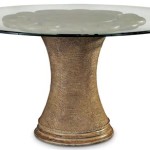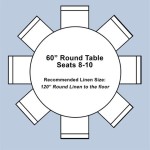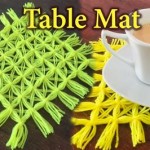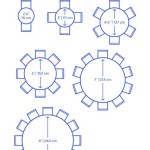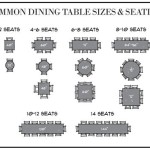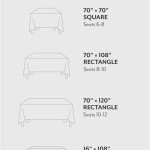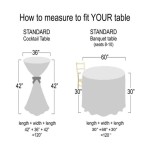To Leave or Not to Leave: The Placemat Dilemma
The presence of placemats on a dining table when not in use is a matter of both personal preference and practical consideration. Whether placemats should remain on the table between meals is a question that often arises in households and dining establishments alike. There are valid arguments for both leaving placemats in place and removing them after each meal. The decision ultimately hinges on factors such as aesthetics, lifestyle, table material, and the desired level of formality.
Understanding the potential benefits and drawbacks of both approaches is crucial in making an informed choice. This article will explore the key points to consider when deciding whether to leave placemats on the table, focusing on the impact on table protection, aesthetic appeal, maintenance requirements, and overall convenience.
Table Protection: A Primary Function of Placemats
One of the primary reasons for using placemats is to protect the table surface. Placemats act as a barrier against spills, scratches, and heat damage. Leaving placemats on the table, therefore, offers continuous protection against these potential hazards. This is particularly important for tables made of delicate materials such as wood, glass, or marble, which are more susceptible to damage.
Consider a scenario where a hot coffee mug is inadvertently placed on a wooden table without a placemat. The heat from the mug can leave a permanent ring mark on the wood's finish. Similarly, accidental spills of acidic liquids like wine or vinegar can stain the table surface if not immediately cleaned. By leaving placemats in place, these minor mishaps are less likely to cause lasting damage.
However, the effectiveness of placemats in providing adequate protection depends on the material and construction of the placemat itself. Some placemats, such as those made of thin fabric, may not offer sufficient protection against heat or spills. In such cases, it is important to choose placemats made of heat-resistant and waterproof materials like cork, vinyl, or silicone. Additionally, the size of the placemat should be adequate to cover the area most likely to be exposed to spills and heat.
It is also important to note that leaving placemats on the table does not guarantee complete protection. Crumbs, dust, and other debris can accumulate underneath the placemats, potentially scratching the table surface over time. Regular cleaning of both the placemats and the table surface is therefore essential, regardless of whether the placemats are left in place or removed.
Furthermore, the type of finish on the table can influence the level of protection required. Tables with durable finishes, such as polyurethane, may be less susceptible to damage than those with delicate finishes like lacquer or wax. In such cases, the need for continuous protection offered by leaving placemats on the table may be less critical.
Aesthetic Considerations: Enhancing the Dining Space
Beyond their protective function, placemats also contribute to the aesthetic appeal of the dining space. Placemats can add color, texture, and visual interest to an otherwise plain table. Leaving placemats on the table can create a more finished and inviting look, even when the table is not in use for dining.
The choice of placemat style can significantly impact the overall aesthetic of the room. For example, woven placemats can add a rustic and natural touch to a farmhouse-style dining room. Conversely, metallic placemats can enhance the elegance of a formal dining setting. The color and pattern of the placemats can also be coordinated with other elements in the room, such as the wall color, curtains, and upholstery, to create a cohesive and harmonious design.
However, leaving placemats on the table can also create a cluttered or busy look, especially if the placemats are poorly chosen or if the table is already adorned with other decorative items. The key is to select placemats that complement the existing decor and to arrange them in a way that is visually appealing. Overlapping or misaligned placemats can detract from the overall aesthetic.
Moreover, the condition of the placemats themselves can affect their aesthetic appeal. Stained, faded, or worn-out placemats can detract from the overall appearance of the dining table. Regular cleaning and replacement of placemats are therefore necessary to maintain their aesthetic value. In some cases, removing placemats when not in use can help to prolong their lifespan by reducing exposure to sunlight and spills.
Ultimately, the decision of whether to leave placemats on the table for aesthetic reasons is a matter of personal taste. Some individuals prefer the look of a bare table, while others appreciate the added visual interest that placemats can provide. Experimentation with different styles and arrangements can help to determine the most pleasing aesthetic for a particular dining space.
Maintenance and Convenience: Balancing Practicality with Aesthetics
The decision of whether to leave placemats on the table also involves considerations of maintenance and convenience. Leaving placemats in place can save time and effort compared to removing and replacing them after each meal. This can be particularly appealing for individuals with busy lifestyles or for families with young children.
However, leaving placemats on the table also necessitates regular cleaning. Crumbs, spills, and dust can accumulate on the placemats and the table surface beneath them. Regular wiping or vacuuming of the placemats is therefore essential to maintain a clean and hygienic dining environment. The frequency of cleaning will depend on factors such as the frequency of meals, the type of food consumed, and the presence of pets or children.
The material of the placemats can also influence the ease of maintenance. Placemats made of smooth, non-porous materials like vinyl or silicone are easier to clean than those made of textured fabrics like linen or cotton. Fabric placemats may require more frequent washing or spot cleaning to remove stains and spills. Some placemats are even machine-washable, which can significantly simplify the cleaning process.
Removing placemats after each meal can also provide an opportunity to clean the table surface more thoroughly. Wiping the table down with a damp cloth can remove any crumbs or spills that may have occurred during the meal. This can help to prevent the buildup of dirt and grime and to maintain the cleanliness and hygiene of the dining area.
In addition, the storage of placemats when not in use can also be a factor in the decision-making process. Removing placemats after each meal requires a designated storage space, such as a drawer or shelf. This can be a challenge for individuals with limited storage space. Leaving placemats on the table eliminates the need for storage but may also result in a less organized or streamlined look.
Ultimately, the decision of whether to leave placemats on the table based on maintenance and convenience is a trade-off between time and effort. Leaving placemats in place can save time but may require more frequent cleaning. Removing placemats after each meal requires more time but may result in a cleaner and more organized dining area.
In summary, the decision of whether to leave placemats on the table is a multifaceted one, influenced by factors ranging from table protection and aesthetic preferences to maintenance requirements and personal convenience. There is no single correct answer, as the optimal approach depends on the specific circumstances and priorities of each individual or household. By carefully considering the various factors involved, one can make an informed decision that balances practical considerations with aesthetic sensibilities to create a dining environment that is both functional and visually appealing.

How To Set The Table With Placemats

How To Use Placemats Ultimate Style Guide French Affair

Placemats Out Of Style

These Cute Placemats Will Keep Your Table Safe Epicurious

How To Use Placemats Ultimate Style Guide French Affair

Do You Put Placemats On Top Of A Table Runner Sastybale

5 Ways To Decorate A Table With Runner Pottery Barn

How Do You Your Placemats

Is It Possible To Keep Placemats From Sliding

Are Felted Wool Placemats Really The Best Epicurious
Related Posts

